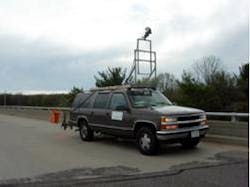Infra-red thermography highlights bridge hot-spots
Engineers at Infrasense (Arlington, MA, USA) have recently completed subsurface investigations of seventeen bridge decks in the Greater Chicago area using infra-red thermography.
The information collected will facilitate planning efforts associated with the $3.4bn Elgin O'Hare Western Access Project, specifically with regards to the widening of the existing expressway.
Infra-red surveys reveal bridge deck delaminations because the delaminations interrupt the flow of heat through the deck. Delaminations occur when the concrete above and below the reinforcing steel begins to deteriorate due to increased stress caused by corrosion of the steel.
Traditional methods for the detection of delaminations in bridge decks -- such as chain dragging and hammer sounding -- take time to perform and require the complete closure of the lane being surveyed.
Despite the location of the decks on the Elgin O'Hare Expressway, which carries a high volume of traffic to and from metro Chicago, the infra-red surveys were performed without causing any traffic disruptions or backups.
During the survey, an Infrasense engineer reviewed the infra-red video data in real-time so that selected areas that appear delaminated in the infra-red image (higher in temperature than surrounding areas) could be hammer sounded to confirm the presence of delamination.
A map of each bridge was produced indicating the locations and areas of delaminations, as well as the areas where sounding was performed for confirmation.
Related articles on infra-red imaging from Vision Systems Design that you might also be interested in.
1. Infra-red detectors made from nanotubes
A team of researchers from Peking University, the Chinese Academy of Sciences, and Duke University (Durham, NC, USA) has harnessed the properties of Single-Walled Carbon Nanotubes (SWNTs) to create a highly sensitive, un-cooled photovoltaic infra-red detector.
2. Matlab helps speed software development of thermal cameras at FLIR
Engineers at FLIR Systems (Wilsonville, OR, USA) have turned to software from The Mathworks (Natick, MA, USA) to help them develop and deploy new algorithms for the company's range of thermal infra-red cameras.
3. An infra-red comeback for the beetles
A team of German researchers from the University of Bonn (Bonn, Germany) have concluded that the sensors of black fire beetles might even be more sensitive than un-cooled infrared sensors designed by man.
-- Dave Wilson, Senior Editor, Vision Systems Design
